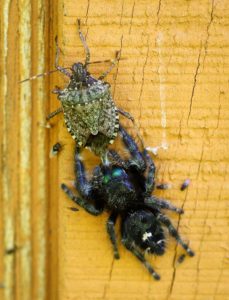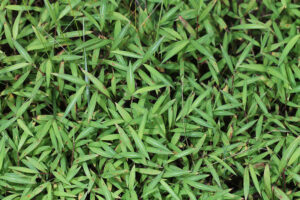 I’m sitting on my back porch watching three stinkbugs climb up my screen. (Sigh) This must mark the beginning of the fall pilgrimage when stinkbugs that have summered over in the grounds outdoors start moving into our comfortable homes to winter over with us, unwelcome guests. But this year I have found a new line of defense against the stinkers: SPIDEY!
I’m sitting on my back porch watching three stinkbugs climb up my screen. (Sigh) This must mark the beginning of the fall pilgrimage when stinkbugs that have summered over in the grounds outdoors start moving into our comfortable homes to winter over with us, unwelcome guests. But this year I have found a new line of defense against the stinkers: SPIDEY!
Spidey is a spider that moved into my screened porch last spring. I noticed Spidey one day with a tight grasp on a stinkbug to that stinkbug’s demise. I had understood stinkbugs to be an alien species with no natural predators in the area, which allows them to thrive (to our great annoyance). We watch, helpless beyond what our local pest control experts can advise.
Stinkbugs are stowaways from Asia first documented in Allentown, Pennsylvania, in September 1998. As of 2010, seventeen states had been categorized as having established brown marmorated stink bug populations, a group in which we are unfortunately included. In addition to becoming a pest for homeowners, stinkbugs have become a serious threat to the nation’s agricultural community. They feed on a wide variety of plants including apples, apricots, Asian pears, cherries, corn, grapes, lima beans, peaches, peppers, tomatoes, and soybeans. In Asia, a parasitoid wasp species is the bugs’ primary predator. The Chinese wasp is not currently present in the United States, but studies are underway on the effects of introducing the wasp into the United States (God forbid) to control the stinkbug population. For now researchers are seeking natural predators of the stinkbug already present in our country. In that search scientists have experimented with different spider species, several of which attacked both the eggs as well as live stink bugs in clinical studies, which perhaps explains Spidey.
Spidey is a jumping spider common to our area. He looks ominous with large pincers (for his size) protruding from the front. They must be effective. Even now I see Spidey’s web woven across the large potted palm tree on my porch with a nice, fat, dead stinkbug hanging upside down in her lacework.
Scientists say global travel and international trade, along with climate change and habitat degradation, are giving rise to invasive species, like the stinkbug, that in turn are giving rise to vector-born diseases. The fact is, we are not just trading goods, we are also trading pathogens. As Jennifer Holland points out in a Sierra Magazine article, “Invasion of the Pathogens:”
-
- Insect-borne diseases like Lyme are fast rising, aided by the spread of invasive species, according to the latest report from the Centers for Disease Control and Prevention (CDC).
- Insect- and other vector-borne-disease cases in the U.S. have nearly tripled in the last dozen years.
- Between 2004 and 2016, bites from mosquitoes, ticks, and fleas led to reported 642,602 human cases of bacterial, viral, and parasite-related illness—with Lyme accounting for 82 percent of those cases.
- Nine of the diseases had never been reported in the United States previously. Seven of the nine are carried by the tick.
As the article points out, ticks aren’t the only vectors spreading new diseases. The travel-born mosquito is another invasive species that can introduce alien pathogens. The mosquito kills some 725,000 people a year via blood-borne disease making it one of the world’s deadliest creatures on earth. Two U.S. intruders, Aedes aegypti, the yellow fever mosquito, which originated in Africa, and Aedes albopictus, the Asian tiger mosquito brought to the U.S. via trade and international travel, are the primary vectors for dengue, chikungunya, yellow fever, and Zika viruses, all now present in the United States.
The invasive disease carriers that come from afar not only can make us sick, but they also reduce the natural biodiversity that helps keep our ecosystems healthy, opening the door to diseases in our landscapes. The Amur honeysuckle, for example, is an invasive species from western Asia that many of us have growing on our banks and in the wild areas of our yard. The invasive honeysuckle overtakes native plants and attracts white-tailed deer. White-tailed deer are hosts to the invasive lone-star tick. According to the article, surveys in Missouri woodlands—not too different from our own—found five times more deer where invasive honeysuckle was prevalent, translating to 10 times as many ticks infected by ehrlichiosis-causing bacteria than in woods without honeysuckle.
Likewise, in Connecticut woodlands, invasive Japanese barberry, a red-fruited garden import now thriving in at least 31 states, supports a 10-fold increase in Lyme-carrying ticks. Not only is the plant perfect habitat for the insects, it also draws both deer and mice, efficient vectors for moving tick nymphs around. (The ticks also spread bacterial nasties like granulocytic anaplasmosis and babesiosis.)
So what can we do to protect our local biodiversity, and ourselves, in this time of global trade and travel? At the very least, we can educate ourselves as to which plants in our landscape are invasives and pull out any non-natives we find, keeping a particular watch on the plants that will be sprouting up in the areas newly uncovered under our dying ash trees. Perhaps in this way we can provide a small oasis of biodiversity in an expansive desert of invasives (most likely a losing battle). Or we can hope that more Spidey’s and other natural predators will emerge and at least help us keep our new (unwelcome) neighbors to a manageable level.
So here’s to Spidey! You will always have a home on my porch. I promise not to smush you or vacuum you up. I will carefully protect you and your webs and continue to take delight in seeing stinkbugs dangling upside down in your netting.
